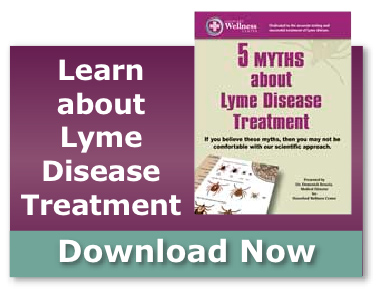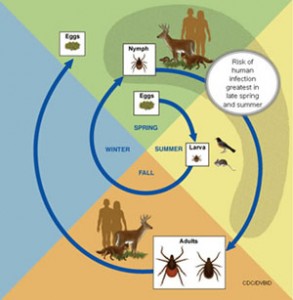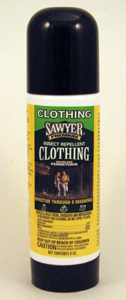Click here to download the PDF.


 The Lyme disease bacterium, Borrelia burgdorferi, normally lives in mice, squirrels and other small animals. It is transmitted among these animals and to humans through the bites of certain species of ticks. In the northeastern and north-central United States, the black-legged tick (or deer tick, Ixodes scapularis) transmits Lyme disease. In the Pacific coastal United States, the disease is spread by the western black-legged tick (Ixodes pacificus). Other major tick species found in the United States have not been shown to transmit Borrelia burgdorferi.
The Lyme disease bacterium, Borrelia burgdorferi, normally lives in mice, squirrels and other small animals. It is transmitted among these animals and to humans through the bites of certain species of ticks. In the northeastern and north-central United States, the black-legged tick (or deer tick, Ixodes scapularis) transmits Lyme disease. In the Pacific coastal United States, the disease is spread by the western black-legged tick (Ixodes pacificus). Other major tick species found in the United States have not been shown to transmit Borrelia burgdorferi.
Blacklegged ticks transmit Lyme disease
Blacklegged (or deer) ticks (Ixodes scapularis and Ixodes pacificus) can transmit several tick-borne diseases including anaplasmosis, babesiosis and Lyme disease. An adult tick is pictured at left, though it is the smaller nymphal stage ticks which most commonly bite humans.
 Life cycle of blacklegged ticks
Life cycle of blacklegged ticks
Blacklegged ticks live for two years and have three feeding stages: larvae, nymph, and adult. Tick eggs are Tick Lyme Disease Treatmentlaid in the spring and hatch as larvae in the summer. Larvae feed on mice, birds, and other small animals in the summer and early fall. When a young tick feeds on an infected animal, the tick takes bacteria into its body along with the blood meal, and it remains infected for the rest of its life. After this initial feeding, the larvae become inactive as they grow into nymphs. The following spring, nymphs seek blood meals in order to fuel their growth into adults. When the tick feeds again, it can transmit the bacterium to its new host. Usually the new host is another small rodent, but sometimes the new host is a human. Most cases of human illness occur in the late spring and summer when the tiny nymphs are most active and human outdoor activity is greatest. Adult ticks feed on large animals, and sometimes on humans. In the spring, adult female ticks lay their eggs on the ground, completing the life cycle. Although adult ticks often feed on deer, these animals do not become infected. Deer are nevertheless important in transporting ticks and maintaining tick populations.
Early Lyme diagnosis and Lyme treatment are critical to a successful cure.
 Insect repellant for ticksSawyer not only repels insects, it actually kill ticks, mosquitoes, chiggers, mites and more than 100 other kinds of insects. Sawyer repellents are for use on clothing, tents and other gear only. A single application will remain effective for up to six weeks, even if you wash the garment once a week.
Insect repellant for ticksSawyer not only repels insects, it actually kill ticks, mosquitoes, chiggers, mites and more than 100 other kinds of insects. Sawyer repellents are for use on clothing, tents and other gear only. A single application will remain effective for up to six weeks, even if you wash the garment once a week.
Visit the Sawyer website for more information or to purchase
 Medical Doctor at Haverford Wellness Center
Medical Doctor at Haverford Wellness Center